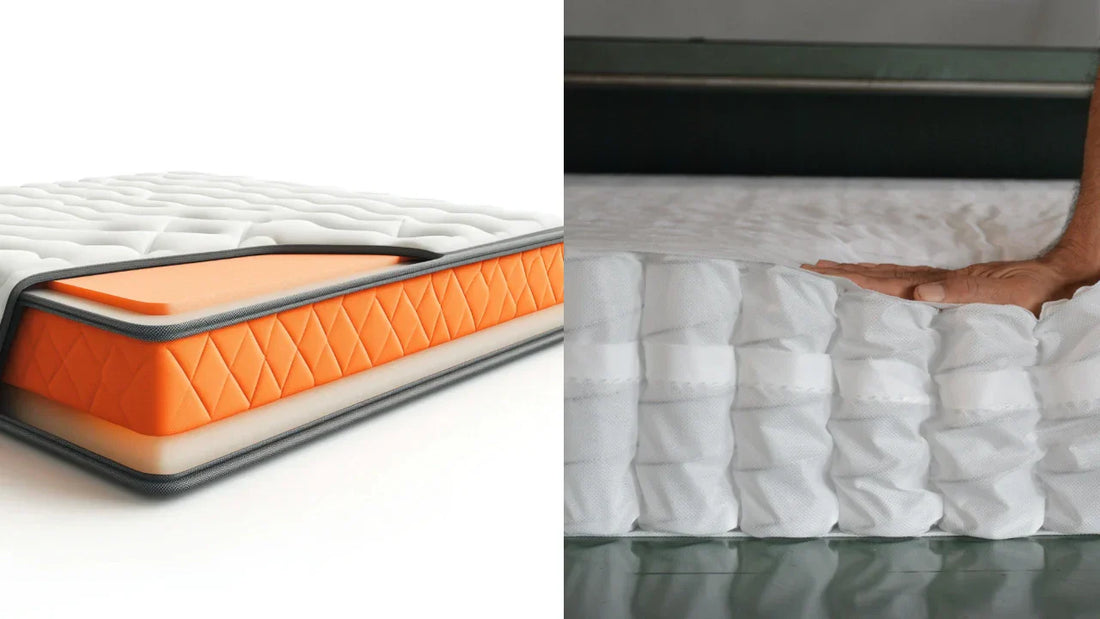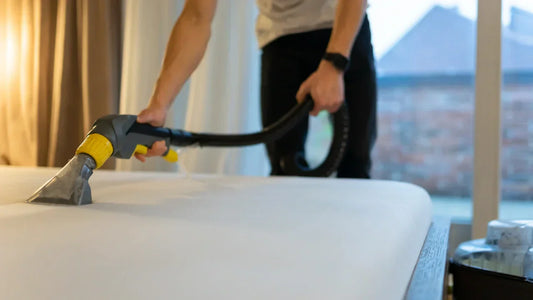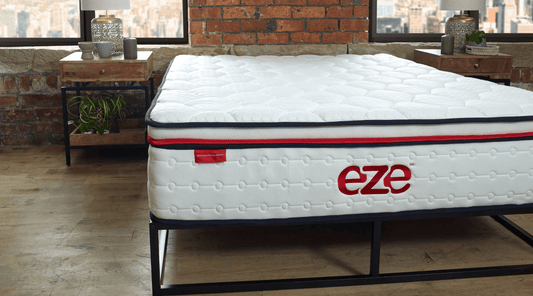Need help choosing a mattress? This is the guide for you.
Here, we’ll compare two of the most popular mattress types - memory foam and spring mattresses.
Let’s get into it:
Comparison Table: Memory Foam vs Spring
| Feature | Memory Foam | Spring/Innerspring |
| Support | Contouring, moulds to body | Responsive, firmer feel |
| Motion Isolation | Excellent – great for couples | Varies – poorer in open coils, better in pocket coils |
| Temperature Regulation | Can retain heat unless gel-infused | Sleeps cooler due to airflow through coils |
| Durability | 7–10 years (depends on quality) | 5–8 years, may sag sooner |
| Comfort Type | Soft-to-medium “hugging” comfort | Medium-to-firm with bounce |
| Best For | Side sleepers, back pain, couples, light to medium builds | Hot sleepers, stomach sleepers, heavier individuals |
What is a Memory Foam Mattress?
A memory foam mattress is a type of mattress that uses memory foam - a soft material that changes shape when you press on it before slowly returning to normal.
Unlike regular foam, which squashes and bounces back, memory foam moulds to the shape of your body first.
This moulding has a lot of benefits for getting a great night’s sleep.
Pros of Memory Foam
-
Pressure Relief: By contouring to your every curve, it helps to ease pressure on those sensitive spots like your hips, shoulders, and knees.
-
Undisturbed Sleep: Memory foam is effective at absorbing movement, so your less likely to wake up if your partner moves.
-
Tailored-Feeling Support: That moulding action helps keep your spine in a more natural line, especially if you’re a side sleeper. It’s like it’s made just for you.
-
It’s Quiet: No springs mean no creaks or groans from the mattress itself.
Cons of Memory Foam
-
Can be hot: Memory foam can sometimes trap body heat, which could lead to night sweats. You can fix this with a gel-infused memory foam mattress.
-
New mattress smell: Sometimes, when you first unwrap a memory foam mattress, there can be a slight smell. It’s called off-gassing, it's temporary, and it usually vanishes within a few days if the room is well-ventilated.
-
The 'Sinking In' Sensation: While some love the hug, others might find memory foam makes them feel a bit too 'stuck', requiring a little more effort to change positions.
-
Heavier to Handle: Good quality, dense memory foam can be quite weighty if you need to move it.
What is a Spring Mattress?
A spring mattress, also known as an innerspring mattress, is a type of mattress that uses a layer of metal springs to provide support and cushioning.
There are several different types of spring mattresses, with each offering their own set of advantages and disadvantages.
The two main types are:
-
Open coils (Bonnell springs): These are the traditional hourglass-shaped mattress coils, often linked together in sets. They’re sturdy and usually more budget-friendly, but you might feel more movement across the mattress.
-
Pocket Coils (or Pocketed Springs): Picture each coil in its own little fabric pocket. They can move independently, meaning they offer more targeted support where you need it, adapt better to your shape, and are much better at stopping motion from travelling across the bed.
Pros of spring mattresses
-
Sleeping Cooler: That open coil structure means air can circulate more freely, which is great news if you tend to overheat at night.
-
Familiar Bounce: Many people simply prefer the responsive, slightly springy feel of spring mattresses that makes it easy to move around.
-
Lots of Firmness Choices: From super soft to extra firm, you’ll find a spring mattress to match almost any preference.
-
Kind to Your Wallet: Basic spring models can be very affordable, though high-end versions with all the bells and whistles (like those lovely pocket coils) will cost more.
-
Good Sturdy Edges: Generally, spring mattresses have pretty solid edges, so you can sit on the side or sleep right up to the edge without feeling like you’ll roll off.
Cons of spring mattresses
-
Feeling the Motion: With those more basic, interconnected coil systems, if your partner moves, you’ll probably know about it. Pocket coils are much, much better at isolating movement.
-
Can Get Noisy Over Time: Sometimes, especially as they get older, springs can start to make a bit of a racket.
-
Watch Out for Sagging: Over time, springs can lose some of their resilience, and the mattress may start to dip or sag, resulting in uneven support.
-
Pressure Points Can Happen: If the comfort layers on top aren’t very thick or plush, you might feel some pressure from the coils, especially if you’re a side sleeper.
Memory Foam vs Spring: Which Is Best For…
The "best" mattress really depends on you and your preferences. So let’s break it down:
Back Pain
Both types of mattresses can help with back pain, but the secret is in the support.
Memory foam moulds to your spine’s natural curve and eases pressure.
The problem is, if it’s too soft without a good supportive core, it might not be enough.
A spring mattress with well-designed pocket coils can also offer fantastic, firm support.
For that "foam vs spring mattress for back pain" dilemma, think about a medium-firm feel in either, or better yet, explore how a hybrid mattress aims to combine support and comfort.
Hot Sleepers
Spring mattresses usually have the edge here, simply because air can move more freely through them.
If your heart is set on foam but you worry about warmth, definitely look for one with modern cooling features (like gels or breathable designs), or consider a hybrid, which often balances these needs.
(Like our Cooleze™ Hybrid Deluxe Mattress or our Cooleze™ Hybrid Original Mattress.)
Couples
Memory foam is often the star for couples.
Why? Because it’s so good at stopping movement from travelling across the bed.
If your partner's tossing and turning is a nightly feature, memory foam might just save your sleep (and maybe your sanity!).
Spring mattresses with pocket coils are the next best for this.
Side Sleepers
Side sleepers often fall in love with memory foam.
It has that lovely ability to cushion your shoulders and hips, letting them sink in just enough while keeping your spine aligned.
A slightly softer memory foam often feels just right.
Stomach Sleepers
Stomach sleepers generally need something a bit firmer to stop their hips sinking in too far (which can put a strain on the spine).
A firm spring mattress, or a very firm, dense foam mattress, is often the recommended choice here.
Back Sleepers
Back sleepers, you’re looking for that sweet spot: enough contouring comfort for your spine’s natural curve, but with solid support underneath.
A medium-firm memory foam mattress or a high-quality medium-firm pocket coil spring mattress can both be great options.
Heavier Body Weight
You’ll generally need a mattress that’s firmer and more durable to give you the right support and prevent premature sagging.
Think high-density memory foam, a robust spring system with strong coils, or a hybrid mattress specifically built to offer enhanced support.
What About Hybrid Mattresses?
Now, what if you’re reading all this and thinking, "I like a bit of what memory foam offers, and a bit of what springs offer… I wish I could combine them!"
Well, you can! That’s exactly what hybrid mattresses are designed to do.
What’s a Hybrid?
Simply put, a hybrid mattress combines a supportive core of pocket springs with significant comfort layers of memory foam.
-
The Balanced Feel: You get the pressure-relieving hug and contouring of foam, plus the responsive, uplifting support and subtle bounce from the springs. Many find it’s "just right."
-
Cooler Comfort: Thanks to that spring layer, air tends to circulate better than in an all-foam mattress, which can mean a cooler night’s sleep.
-
Support Meets Comfort: The goal is to provide you with the deep-down, targeted support your spine needs from the springs, combined with the cushioning comfort of foam on top.
-
Good for Couples: Quality hybrids with pocket coils are pretty good at stopping motion from travelling, making them a strong contender if you share your bed.
-
Built to Last: A well-made hybrid can be a very durable choice.
Often, you'll find that hotels use high-quality hybrid or traditional spring mattresses because they offer a blend of comfort and support that suits a wide range of people.
So, What’s the Verdict? Foam or Spring?
As you’ve probably gathered, there isn’t a single champion here
Whether a memory foam mattress or a spring mattress is "better" really comes down to your personal checklist: what feels good to you, how do you sleep, what’s your budget, and what are your priorities?
Memory foam is your go-to for that body-hugging, pressure-easing feel and for keeping partner disturbance to a minimum.
Spring mattresses offer that classic responsive bounce and a generally cooler sleep.
If you’re looking for something that aims to blend these strengths, taking the best bits from each, then exploring a hybrid mattress like those in our eze range could be a fantastic next step.
Think about what’s most important for your best night’s sleep.
Is it that cloud-like cushioning, that solid underlying support, or a clever mix of both?
Do a little research, maybe check out some more tips on our blog, and you’ll be well on your way to finding the mattress that’s just right for you. Sweet dreams!









